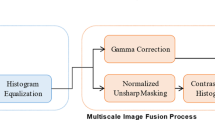Abstract
Major issue in marine environment imaging is the expulsion of hazy scenes caused by natural phenomena such as absorption and scattering in underwater images. The visual appearance of the underwater image needs to be improved. In this paper, a double stage Gaussian filter (DSGF) and fusion-based approach to enhance the underwater images is proposed. In the proposed two stage process for image fusion, first section deals with applying the DSGF with high, low, and medium sigma values on the individual R, G and B components of input RGB images and second section deals with applying colour component wise contrast limited adaptive histogram followed by median filtering. The outputs of these two sections are fused using principal component analysis fusion technique. Fused image is post-processed using the colour contrast correction for better visibility results. Proposed method is compared with single stage Gaussian filter where only one stage of Gaussian filtering is applied for reduced computation, Adaptive histogram equalization and histogram specification methods. Proposed method results in quality images obtained through gradual intensity improvement and contrast correction process. Qualitative and quantitative analysis are performed on the enhanced underwater images to observe the effectiveness of the algorithm used. The performance measures such as entropy, SSIM, and AMBE unveil the verification of the proposed findings.


Similar content being viewed by others
References
Borker, S., & Bonde, S. (2017). Contrast enhancement and visibility restoration of underwater optical images using fusion. International Journal of Intelligent Engineering and Systems. https://doi.org/10.22266/ijies2017.0831.23.
Vembuselvi, V., & Murugan, T. (2016). Enhancement of underwater images using CLAHE algorithm. International Journal of Innovative Research in Science, Engineering, and Technology, 5(2), 162–166.
Singh, R., & Biswas, M. (2016). Adaptive histogram equalization based fusion technique for hazy underwater image enhancement. In IEEE international conference on computational intelligence and computing research. https://doi.org/10.1109/ICCIC.2016.7919711.
Dithee Dev K., & Natrajan, S. (2015). Underwater image enhancement for improving the visual quality by CLAHE technique. International Journal of Scientific Research Engineering & Technology (IJSRET), 4(4), ISSN 2278-0882.
Gupta, A., Sandesh, J., Gautam, R., & Saurabh, N. (2017). Image enhancement using histogram equalization of saturation in HSV color space. International Journal of Industrial Electronics and Electrical Engineering, 5(5), ISSN: 2347-6982.
Hitam, M. S., & Awalludin, E. A. (2013). Mixture contrast limited adaptive histogram equalization color models for underwater image enhancement. In Computer Applications Technology (ICCAT), 2013. https://doi.org/10.1109/iccat.2013.6522017.
Saini, S., & Mishra, P. K. (2017). Image enhancement of underwater digital image using L*A*B color space on unsharp masking. International Journal of Advanced Research in Computer and Communication Engineering. https://doi.org/10.17148/IJARCCE.2017.6234.
Dixit, S., Tiwari, S. K., et al. (2016). Underwater image enhancement using DCP with ACCLAHE and homomorphism filtering. In International conference on signal processing, communication, power and embedded system (SCOPES)-2016. https://doi.org/10.1109/scopes.2016.7955807.
Iqbal, K., Salam, R. A., et al. (2007). Underwater image enhancement using an integrated colour model. IAENG International Journal of Computer Science, 34, 2.
Ansar, M. K., & Vimal Krishnan, V. R. (2014). Performance evaluation of image fusion algorithms for underwater images—A study based on PCA and DWT. International Journal of Image, Graphics and Signal Processing, 12, 65–69. https://doi.org/10.5815/ijigsp.2014.12.09.
Wang, Y., Ding, X., et al. (2017). Fusion-based underwater image enhancement by wavelet decomposition. In IEEE international conference on industrial technology (ICIT), 2017. https://doi.org/10.1109/icit.2017.7915500.
Babool, J. K., & Singh, S. (2016). Evaluation of single underwater image enhancement with CLAHE. International Journal of Advanced Research in Computer and Communication Engineering. https://doi.org/10.17148/IJARCCE.2016.55187.759.
Voronin, V., Semenishchev, E., Tokareva, S., Zelenskiy, A., & Agaian, S. (2018). Underwater image enhancement algorithm based on logarithmic transform histogram matching with spatial equalization. In 2018 14th IEEE international conference on signal processing (ICSP), Beijing, China, (pp. 434–438). https://doi.org/10.1109/icsp.2018.8652298.
Song, W., Wang, Y., Huang, D., Liotta, A., & Perra, C. (2020). Enhancement of underwater images with statistical model of background light and optimization of transmission map. IEEE Transactions on Broadcasting, 66(1), 153–169. https://doi.org/10.1109/TBC.2019.2960942.
Ji, Y., Tu, D., Zhang, X., Jin, Y., & Li, C. (2019). Light field camera image sharpness enhancement for underwater machine vision application. In 2019 2nd World conference on mechanical engineering and intelligent manufacturing (WCMEIM), Shanghai, China (pp. 499–503). https://doi.org/10.1109/wcmeim48965.2019.00105.
Wang, Y., Song, W., Fortino, G., Qi, L., Zhang, W., & Liotta, A. (2019). An experimental-based review of image enhancement and image restoration methods for underwater imaging. IEEE Access, 7, 140233–140251. https://doi.org/10.1109/ACCESS.2019.2932130.
Liu, P., Wang, G., Qi, H., Zhang, C., Zheng, H., & Yu, Z. (2019). Underwater image enhancement with a deep residual framework. IEEE Access, 7, 94614–94629. https://doi.org/10.1109/ACCESS.2019.2928976.
Ryu, J., Hong, S., & Yang, H. S. (2013). Sorted consecutive local binary pattern for texture classification. IEEE Trans. Image Process.. https://doi.org/10.1109/TIP.2015.2419081.
Zhang, J., Liang, J., & Zhao, H. (2013). Local energy pattern for texture classification using self-adaptive quantization thresholds. IEEE Transactions on Image Processing, 22(1), 31–42. https://doi.org/10.1109/TIP.2012.2214045.
van de Weijer, J., Gevers, T., & Gijsenij, A. (2007). Edge-based color constancy. IEEE Transactions on Image Processing. https://doi.org/10.1109/TIP.2007.901808.
Hong, X., Zhao, G., Pietikinen, M., & Chen, X. (2014). Combining LBP difference and feature correlation for texture description. IEEE Transactions on Image Processing, 23(6), 2257–2568. https://doi.org/10.1109/TIP.2014.2316640.
Guao, Z., Zhang, L., & Zhang, D. (2010). Rotation invariant texture classification using LBP variance (LBPV) with global matching. Pattern Recognition, 43(3), 706–719. https://doi.org/10.1016/j.patcog.2009.08.017.
Mehta, R., & Egiazarian, K. (2016). Dominant rotated local binary * patterns (DRLBP) for texture classification. Pattern Recognition Letters, 71, 16–22. https://doi.org/10.1016/j.patrec.2015.11.019.
Jiang, G., Lin, S. C. F., Wong, C. Y., Rahman, M. A., & Ren, T. R. (2015). Color image enhancement with brightness preservation using a histogram specification approach. Optic, 126, 5656–5664. https://doi.org/10.1016/j.ijleo.2015.08.173.
Author information
Authors and Affiliations
Corresponding author
Additional information
Publisher's Note
Springer Nature remains neutral with regard to jurisdictional claims in published maps and institutional affiliations.
Rights and permissions
About this article
Cite this article
Selva Nidhyanandhan, S., Sindhuja, R. & Selva Kumari, R.S. Double Stage Gaussian Filter for Better Underwater Image Enhancement. Wireless Pers Commun 114, 2909–2921 (2020). https://doi.org/10.1007/s11277-020-07509-6
Published:
Issue Date:
DOI: https://doi.org/10.1007/s11277-020-07509-6




